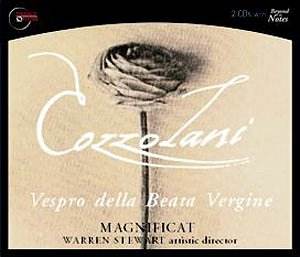 Composer: Chiara Margarita Cozzolani
Composer: Chiara Margarita Cozzolani
Works: Vespro della Beata Vergine, Second Vespers for the Feast of the Annunciation of the Blessed Virgin
Performers: Coro Primo: Catherine Webster, Margaret Bragle, Jennifer Ellis, Jennifer Lane, Karen Clark; Coro Secondo: Ruth Escher, Suzanne Elder Wallace, Andrea Fullington, Elizabeth Anker; John Dornenburg, violone; David Tayler, theorbo; Hanneke van Proosdij, organ
Recording: Rec: April 1995, April 1998, March-May 1999, August 2000, June 2001, various locations
Label: Musica Omnia
Chiara Margarita Cozzolani, a Benedictine nun hailing from Milan, occupies a unique niche in the canon of Baroque music, particularly within the realm of sacred choral compositions. Her “Vespro della Beata Vergine,” written during a time when women composers were often relegated to the margins of musical history, reveals a rich tapestry of liturgical fervor and emotional depth. The work, which showcases her mastery of polyphony and a keen sense of dramatic expression, reflects the cultural milieu of 17th-century Milan, a city steeped in artistic fervor and religious devotion. The present recording is not only a world premiere of Cozzolani’s Second Vespers but also serves as an entry point into her remarkable oeuvre.
The performance, conducted by Warren Stewart, captures the essence of Cozzolani’s style with remarkable fidelity. Right from the opening Versiculus et Responsorium: “Deus in auditorium,” one is struck by the lush textures produced by the eight-voice choir. The ensemble’s sonority is vibrant, and they navigate the intricate interplay of voices with both precision and warmth. The choice to employ soloists within the choral fabric enhances the work’s dramatic variety; for example, the solo lines in “Ave Maria” soar with a lyricism that transports the listener, evoking the fervent spirituality characteristic of Cozzolani’s writing. The choir’s ability to shift between ethereal harmonies and robust choral passages exemplifies the madrigal influences that permeate her compositions.
The technical execution of the choir deserves particular commendation. The singers display a remarkable blend of clarity and blend, managing to maintain individual line integrity while simultaneously creating a cohesive choral sound. The dynamic contrasts are well-controlled, allowing for a nuanced interpretation of the psalms, especially in “Dixit Dominus” and “Laudate Pueri,” where the intricate counterpoint is rendered with both vigor and delicacy. The recording captures these subtleties, placing the ensemble in a resonant acoustic that enhances the natural warmth of their voices.
Sound quality is of paramount importance in this recording, and Musica Omnia excels in presenting the choir’s tonal richness. The engineering choices allow the subtle interjections of the organ and theorbo to shine through without overwhelming the vocal lines, creating a balanced soundscape that immerses the listener in the music’s sacred atmosphere. The inclusion of the ‘Beyond the Notes’ CD enriches the experience, offering insightful commentary that contextualizes Cozzolani’s work and enhances one’s appreciation of the musical intricacies.
Cozzolani’s music, often overlooked, shines brilliantly in this recording, revealing a composer who, despite her historical obscurity, possesses an unmistakable voice that resonates with emotional depth and spiritual intensity. The attention to detail in both performance and production makes this release a significant addition to the repertoire of early music. The enchanting sound world crafted by Cozzolani, coupled with the impeccable execution by the performers, ensures that this recording will not only captivate new listeners but also deepen the understanding of those already familiar with her work. This is a remarkable endeavor that calls for immediate attention from all who cherish the intersection of history, spirituality, and musical innovation.



